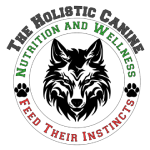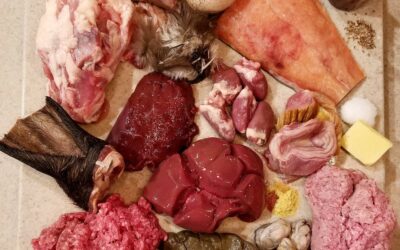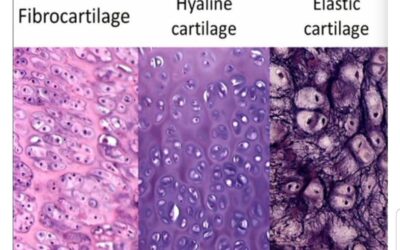Feeding your dog a raw diet of fresh meats, nutrient-rich organs, raw meaty bones, and other nourishing whole-foods is the most natural and species-appropriate option available. When offered and provided correctly, dogs indisputably thrive. Notice the key word here… correctly. As raw feeding becomes more and more commonplace and the internet fills with information, many pet parents are taking the switch to raw into their own hands. And thanks to the Pet Fooled documentary (available of Netflix), the raw food movement is exploding not just within the United States, but has been across the world.
When it comes to taking the responsibility to provide for your dog’s nutritional needs, research and knowledge are not optional. Even for me, being a board certified practitioner and nutrition professional since the 1990s, I did not take the switch from commercial food to homemade lightly. Dogs have very specific nutrient requirements that must be provided or health will inevitably suffer. In my practice, I have observed “common mistake” trends made by pet parents who are new and newish to raw feeding. Here are some common mistakes as well as suggestions for how to avoid and/or make amendments to be sure your dog will flourish on a raw diet.
1. Failure to do adequate research
Face it, research can be an arduous and laborious process especially when there can be steep consequences to not doing enough. When it comes to a basic need that can spell health or harm (quite literally), research is not to be scrimped upon. Nutrition is vital to life and all processes that sustain and maintain life. I would very much doubt that any pet parent is not hoping for many, many years of health and joy with their beloved companions. Thus, getting your dog’s nutritional needs adequately met is a vital step toward that goal of long ages and stellar health.
Switching to raw is more than simply providing raw ground beef and broccoli with an occasional marrow bone or a bunch of chicken quarters or backs day in and day out. Dogs have a need for a variety of meats, organs, bones, and other foods in varying quantities in order to create a truly complete and balanced nutrition plan. There is the need to know how much food to provide and how much of each ingredient is going to be required to provide all of the essential amino acids, fats, vitamins, and minerals.
A situation in my practice that often needs addressing is the exclusive feeding of the popular commercially and locally prepared 80/10/10 grinds. Most of these products are not “complete and balanced.” While the ingredients may be exceptional quality, most of these products offer only a good dietary base with the need for added ingredients and sometimes supplementation. If you are feeding a commercial or locally created 80/10/10 pet food product that does not come with a “complete and balanced” label or guarantee, chances are you are feeding a significantly deficient product.
You must determine if what you are feeding your dog is either providing all of your dog’s nutrient needs or is deficient or imbalanced and in need of amending. This is where research pays off in a big way. While you can pay a professional do all the work for you, such as myself who would be happy to analyze your pet’s diet, most pet parents are perfectly capable of discovering what nutrients are being supplied and which nutrients are lacking in their dog’s meals.
If you are not sure where to begin, start here. Every pet parent who is or will be raw feeding must have their dog’s specific daily nutrient requirements. You can determine this by using our free NRC nutrient requirement calculator here. Once you know your dog’s nutrient needs, begin to source ingredients that contain the nutrients your dog requires. You will need to use a spreadsheet calculator to audit the nutrients in the meals you create. You can find free spreadsheet calculators in The Holistic Canine Facebook community group. If you do not mind purchasing a low-cost program, you might consider the Pet Diet Designer (PDD) software (not available for Mac users) for your laptop or PC. This software can help you determine deficiencies and imbalances in your pet’s meals (DISCLAIMER, the PDD software does not account for bone and can be very frustrating for pet parents who do not have assistance knowing how to account for missing information in the program). If none of these are a possibility, you can use the USDA Food Composition Database to learn the nutrient profiles of what you are feeding to calculate your nutrient totals.
2. Believing that feeding a ratio means you are providing a “balanced” diet
Ratios are a great guideline for creating meals. The 80/10/10 ratio (80% meat, 10% organs, 10% bone) is the approximate ratio of whole prey. Because most pet parents who choose raw want to provide a species-appropriate diet that most closely resembles a natural carnivorous diet, following the 80/10/10 ratio (or one similar) just seems to make so much sense. And while it does make sense, providing meals based only on the ratio without any regard for nutrients is the most common cause for nutrient deficient meals. While nutrient toxicities are less common, they can occur especially with a consistent amount of liver, other secreting organs, and supplements in every meal. Ratios must be balanced properly if your goal is to cultivate optimal health and promote healing.
Consistently providing your dog with meals that are unbalanced greatly increases the very real possibility for nutrient-deficient or nutrient-toxic pathologies and conditions. Understand that conditions do not occur over night. It takes months and sometimes years for unbalanced nutrition to create problems or damage. Early symptoms are often overlooked and dismissed as sensitivities and allergies whether to food or the environment. Other signs include skin that won’t heal, hot spots, excessive licking, other skin conditions, thinning coat, difficulty maintaining weight, joint injuries, ligament damage, hip problems, poor eyesight, ear conditions, behavioral changes including anxiety or aggression, excessive hunger or thirst, skipping meals, lack of energy, withdrawn or depression, hyperactivity, scatterbrained, increased thirst with an inability to urinate, and more.
If you are unsure if the meals you are providing for your dog are balanced, refer to number 1 above to audit nutrients.
3. Neglecting to balance the fats
This is a biggie in my practice. It is also a big concern in human nutrition as well. Not all fats are created equally and each fatty acid has its own specific function and purpose. Dogs need to receive each essential fatty acid in the correct balance. The two categories of essential fatty acids that dog must receive from their diet are omega-6 and omega-3 fatty acids. Getting enough of the essential omega-6 fatty acids is easy to do, in fact so easy that this is usually the cause for the fat imbalance.
Farm animals raised for food are primarily fed grains, especially conventionally farmed animals that end up for sale in grocery and food store meat cases across the country to nourish the general public. These meats are regulated by agencies that ensure quality and safety. More often than not, pet parents are feeding their dogs this same meat from conventionally farmed animals. Due to the type of feed that is consumed by livestock during their life, the end result is a meat product high in omega-6 fatty acids. This applies to poultry, beef, pork, goat, lamb, and eggs. Omega-6 fatty acids also happen to be inflammatory fats. Balancing the fatty acids is crucial to prevent an inflammatory environment within your dog’s body. This is done by feeding a balance of omega-3 fatty acids along with omega-6 rich meats in a ratio of 2:1 or 3:1 omega-6 to omega-3. The key word here is balance. Dogs with certain health concerns and chronic disease may be better with a 1:1 ratio.
Livestock that are raised out on pasture and free-ranged will have higher levels of omega-3 fatty acids. The meat and eggs from these animals unfortunately also tend to be very costly. The cost is often so high that many families cannot afford these meats even for themselves much less their dog. Feeding fatty fish such as sardines, salmon, and mackerel can easily provide the needed omega-3 fatty acids. But the safety of fish is often questioned as well as sourcing and pricing. Farmed fish is not ideal and wild-caught can be very pricey and is generally available seasonally. This is an example where supplementation may prove a better option for some pet parents over more costly omega-3 rich foods. Be sure to choose a source to balance the fats in your dog’s diet as this is essential for overall health.
As a word of caution, the trend for a supplemental omega-3 source is fish oil. And as with most things, there are a few concerns about utilizing fish oil. Fish oils have the unfortunate problem of rancidity. No matter how wonderful the quality, rancidity is a major problem. As soon as the extracted oil hits the air, oxidation occurs even through gelcaps. Refrigeration is helpful, but I have my doubts. Rancid fish oils will contribute to a highly inflammatory environment within your dog’s body. Additionally, if you’re not spending a good bit of money on a natural supplement with a purity guarantee, you are likely buying a contaminated product containing mercury and PCBs (among others) with the bonus of extraction chemicals. And lastly, the very high levels of omega-3 fatty acids in fish oil can actually create health concerns. Just like too many omega-6 fatty acids can lead to a potential disease state, so too, omega-3 fatty acids in amounts well over what is needed can create health concerns.
My first choice for omega-3 fatty acids is food. Wild-caught sardines and mackerel are excellent, relatively low in contaminants, and are also superb sources of protein, phosphorus, calcium, magnesium, B vitamins, and vitamin D. Canned fish is also acceptable. My choices for supplements are krill oil and marine phytoplankton. The omega-3 fatty acids in krill oil are more readily and easily absorbed because krill contains astaxanthin, a powerful antioxidant. This is also what makes krill oil safer and less prone to oxidation. The lesser amounts of fatty acids also make krill oil innocuous. Marine phytoplankton is high in omega-3s and rich in protein, minerals, and vitamins.
Again, balance is critical. More is not better! Balance is everything.
4. Expecting or holding on to unrealistic results
While raw feeding has a plethora of benefits, switching your dog to raw and holding on to unrealistic goals is not only frustrating, but creates a stigma that can deter other pet parents from transitioning to a species-appropriate diet and providing their best for their pets. It is unfortunate that many pet parents do not learn about raw feeding until after their dog has been suffering or is diagnosed with a chronic condition; the worst case, cancer. It is often the pet parent’s desperate research to learn ways to help their chronically damaged or ill dog that leads them to discovering that diet plays a major and critical role in health and healing, and that a raw diet just may be the answer. While there is no doubt that transitioning a suffering or chronically ill dog to a species-appropriate raw diet can help, how much help is dependent solely upon how badly damaged a dog’s body, immune, and organ function is at the time of transition. Sadly, for many dogs, it is simply too late for their compromised system to recover. Irreversible damage is the sad and heartbreaking case with many cancers. Dogs do not generally show symptoms of cancer until it has already advanced. This is exactly the reason why prevention is critical.
While many dogs have in fact reversed conditions, disease, and even cancer by being transitioned to a raw diet, not every dog is so fortunate. Pet parents would be wise to hold on to the fact that by choosing a raw diet in their dog’s final months, weeks, or even days has provided them with the absolute best nutrition plan possible and likely the most enjoyable meals of their dog’s life. Many dogs transitioned to raw in their golden years or at the tail end of disease end up passing peacefully and in very little pain. As with everything in this world, nothing is a guarantee except that all living beings have their time that must eventually come to an end. A raw diet can and most often does create a platform for reduced pain, decreased symptoms, and enjoyable meal times.
Transitioning to raw can be a wonderfully amazing journey for both dog and pet parent. But be realistic and hold on to the joy and peace that raw feeding can bring to a suffering and ill animal.
5. Over supplementing (or ignoring supplementing altogether)
Taking your dog’s nutritional needs into your own hands can be a very daunting and frightening task. To help ease concerns, many well-intentioned pet parents turn to excessive supplementation, or what I call bottled insurance policies. While supplements may be indicated in certain circumstances, supplements used wrongly can create a serious imbalance that may put your dog at an increased risk for harm. To know whether or not a supplement may be required, you must first know if a deficiency exists consistently within meals, if anti-nutrients need to be countered, or if you require a synergistic nutrient to assist absorption. Only an audit of your meals will accurately determine this. You can use a spreadsheet calculator or a diet designer software as referred to in number 1 above.
For example, if your meals are consistently low in zinc and you are unable to feed enough beef, oysters, or gizzard to meet your dog’s zinc requirement, adding a LOW dose organic (chelated to an amino acid ONLY) zinc supplement may be indicated. Be mindful that consistent use of zinc can create a copper and manganese deficiency especially if levels of these antagonistic nutrients are also low. I am not a fan of nutrient isolates as it is quite easy to create imbalances thus becoming potentially harmful.
If you are using a multi vitamin and mineral supplement, my best advice is to seek the help of a nutrition professional such as myself to determine if the addition is advantageous or is potentially setting your dog up for a health crisis. To be certain that any supplement is needed, I also suggest consulting with me especially if you are unsure.
I do advocate the use of food-source supplements. These food supplements can be added to meals just as a food without the calorie load and the benefit of nutrient saturation. I love to add and rotate among barley grass and wheat grass powders, spirulina, alfalfa, green lipped mussel powder, phytoplankton, kelp (WATCH the iodine content and feed with CAUTION!), whole fruit powders, krill oil, mushroom powders, colostrum, and more. However, you must know why you are adding these supplemental foods. These concentrated food sources are rich in nutrients and, while not as likely, could potentially create an imbalance if used excessively.
6. Not sourcing enough ingredients
Animals, like us humans, need a variety of foods to meet nutrient needs and to create an ideal platform for optimizing nutrient uptake and assimilation. Consistently feeding a limited amount of ingredients or neglecting to feed a variety of proteins can create serious deficiencies. Each protein and organ source contains its own unique nutrient profile. Both macro (proteins and fats) and micronutrients (vitamins and minerals) vary greatly among and within foods. Some foods are richer in certain nutrients than others and thus should be fed to supply those particular nutrients. Unless you are feeding whole prey, limited protein sources will not be sufficient without numerous additional ingredients or supplements to create balance, and supplements are not ideal.
What is of most concern is the nutrient antagonism and synergism. Feeding a limited amount of food ingredients consistently subjects your dog to similar antagonism and synergism. This can eventually lead to an imbalance and reduced nutrient absorption. Nutrient uptake is optimal with variety.
Ideally, you will want to feed your dog foods from poultry, mammals, and fish. This includes muscle meat along with a variety of organ meat. Organ meat is heavily saturated in nutrients and is therefore fed in smaller quantities. Eggs are nature’s “perfect food” and are an ideal addition to meals as well. Many pet parents also add vegetables, fruits, and seeds to further increase nutrient saturation. The more variety you can offer to your dog, the easier it is to feed balanced meals.
Remember to feed only those foods that are species-appropriate for dogs. This ensures ease of digestion and optimal nutrient absorption. Your dog is a facultative carnivore that must have meat, organs, and bones to cultivate optimal health.
©2019 Kimberly Lloyd, PhD, BCHHP, Cert Raw Dog Food Nutritionist



